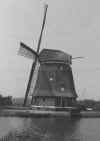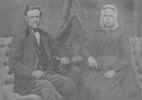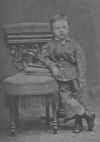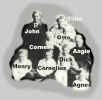|
by Henry Slotemaker
Part One---Holland
 This story begins in the Netherlands, in the village of Noord
Scharwoude in the province of North Holland, in the spring of 1839. It
is located in a "polder", (land reclaimed from the sea). It
is one of a row of villages built on
the dyke, the street separating
the buildings from the canal. Farmers all lived in the villages on the
dyke. Farming was chiefly dairying and
vegetable growing. This story begins in the Netherlands, in the village of Noord
Scharwoude in the province of North Holland, in the spring of 1839. It
is located in a "polder", (land reclaimed from the sea). It
is one of a row of villages built on
the dyke, the street separating
the buildings from the canal. Farmers all lived in the villages on the
dyke. Farming was chiefly dairying and
vegetable growing.
Residents of this village in whom we are
interested are two young families. The surnames are Slotemaker and
Keppel. They are on their way home from a Sunday morning worship
service. Both families had their first born baptized at this service.1
[He was born March 8; She April 13, 1839] The Slotemakers invited the Keppels in for coffee. The babies,
Cornelis Slotemaker and Aagje Keppel were placed in the same crib to
sleep. The fond parents jestingly observed that this could well be the
beginning of a lifelong relationship. This casual observation may well
have reflected an unexpressed desire on the part of these parents. this service.1
[He was born March 8; She April 13, 1839] The Slotemakers invited the Keppels in for coffee. The babies,
Cornelis Slotemaker and Aagje Keppel were placed in the same crib to
sleep. The fond parents jestingly observed that this could well be the
beginning of a lifelong relationship. This casual observation may well
have reflected an unexpressed desire on the part of these parents.
Aagje grew up to be a tenderhearted,
affectionate, sensitive young woman with a rather delicate physique as
was common for the girls of her generation. She was being prepared to
take her place as a home-maker. Cornelis early in life indicated  aggressiveness, a readiness to meet the challenges of life. He
demonstrated a desire and ability to excel in many things he
attempted. Let one illustration suffice. Cabbage was one of the
principal vegetable crops.
aggressiveness, a readiness to meet the challenges of life. He
demonstrated a desire and ability to excel in many things he
attempted. Let one illustration suffice. Cabbage was one of the
principal vegetable crops. Transplanting the plants from seedbed to
field was a busy time. A skillful planter could transplant 1000 plants
per hour. A specially designed spade was used for this. A boy
accompanied the planter, carrying a basket with plants, handing one
plant at a time to the planter. No markers were used to make straight
rows, yet rows were straight in both directions, equal distance apart
both ways. On one occasion Cornelis wanted to set a record, which he
did by planting 2000 plants in an hour. This record still stood when
they left the Netherlands.2 Transplanting the plants from seedbed to
field was a busy time. A skillful planter could transplant 1000 plants
per hour. A specially designed spade was used for this. A boy
accompanied the planter, carrying a basket with plants, handing one
plant at a time to the planter. No markers were used to make straight
rows, yet rows were straight in both directions, equal distance apart
both ways. On one occasion Cornelis wanted to set a record, which he
did by planting 2000 plants in an hour. This record still stood when
they left the Netherlands.2
 As neighbors Cornelis and Aagje saw much of each
other. They also attended the same school and the same church. Her
delicate physique and tender compassion for anyone or anything
appealed to him; while his bold aggressiveness gave her a sense of
security. Complementing one another in this way soon led them to
realize that they were more than friends and neighbors, they were
lovers. This love was consummated in their marriage As neighbors Cornelis and Aagje saw much of each
other. They also attended the same school and the same church. Her
delicate physique and tender compassion for anyone or anything
appealed to him; while his bold aggressiveness gave her a sense of
security. Complementing one another in this way soon led them to
realize that they were more than friends and neighbors, they were
lovers. This love was consummated in their marriage which took place on
July 5, 1862. On June 6, 1865 the family was increased by the birth of
a daughter whom they named Anna. On Aug. 6, 1870 son Jan
was born.
About 5 years later another boy was born to them whom they named Dirk.
This was a child who gave his parents much concern because of a frail
body and failing health. Yet he was also a source of much happiness
and a means for deepening the spiritual life of his which took place on
July 5, 1862. On June 6, 1865 the family was increased by the birth of
a daughter whom they named Anna. On Aug. 6, 1870 son Jan
was born.
About 5 years later another boy was born to them whom they named Dirk.
This was a child who gave his parents much concern because of a frail
body and failing health. Yet he was also a source of much happiness
and a means for deepening the spiritual life of his  parents as he gave
evidence of a strong faith in God, and assurance of salvation. This
also gave them much comfort when at the tender age of 5 years he
departed this life to be with his Savior. The exact dates of his birth
and death have been lost track of.3 This experience of sorrow had a
mellowing influence on Cornelis who now displayed a great tenderness
toward Aagje, who found great difficulty in bearing her grief. parents as he gave
evidence of a strong faith in God, and assurance of salvation. This
also gave them much comfort when at the tender age of 5 years he
departed this life to be with his Savior. The exact dates of his birth
and death have been lost track of.3 This experience of sorrow had a
mellowing influence on Cornelis who now displayed a great tenderness
toward Aagje, who found great difficulty in bearing her grief.
However the death of a loved one and the
resulting sorrow do not determine the course of life of those who
remain. Grandpa and Grandma (as we shall now refer to them) had been
giving serious thought to emigrating from the Netherlands. This urge
was of course much the stronger in Grandpa whose adventurous nature
could in this way be satisfied. Besides this, the Franco-Prussian war
of 1870 was still fresh in their memory. While there was outward
peace, there was no friendship between the two countries, and future
hostilities were considered inevitable by the careful observer. And if
there was one thing the Dutchman wanted no part in was to be involved
in a European war. Then too there was the fast increasing population
with a resulting strain on the economy. Although at the time the Dutch
farmer was upper middle class, and grandpa and family were living in
comfort, the future in this respect was questionable. Finally, there
was the disturbing fact that the State Church was continuing to oppress
the free church.4 They still were members of the State Church, as there
was no free church in their community. As I remember grandpa telling
about it, they attended evangelistic services sponsored by a voluntary
local group who professed the historic Christian faith, which was
rejected by many in the State church.
In making plans for departure from the homeland,
two countries drew their attention: the United States of America and
the Republics of South Africa. It must be remembered that this was two
decades before the Boer War, and the Transvaal and the Orange Free
State were independent republics to which tens of thousands Dutch
people had migrated and where the Dutch language was the official
language. I do not know what led to the final decision, but I think
that the fact that the South African republics were small and that the
British had a growing interest in the area, and the fact of frequent
friction between the British and the Dutch settlers was a determining
factor. It seems that Grandpa had little respect for the British, at
least he would be careful to avoid living under British rule or in a
British colony. Yet they made no hasty decision about making the big
move. America was so large, which accounted for vast variations in
climate, agriculture, industry, etc. They were also determined to
settle in a community where there were other Dutch immigrants with a
church in which they could worship in harmony with their convictions.
While Iím sure that they made their contemplated move a matter of
daily prayer, it is evident that they expected no special revelation
as to what to do or where to go. They made their plans with the utmost
of care. This is evident from the fact that Grandpa made a trip of
investigation before making the final decisions. This trip across the
Atlantic was made in a sailing vessel. The only thing that I can
remember him telling about this trip was that a storm drove them off
course, causing delay, and the nearly total exhaustion of their
provisions.
The primary objectives of his investigation were
Southwestern Michigan and parts of Iowa. Having farmed in a
"Polder", (land reclaimed from the sea) the sandy and muck
soils of Michigan held little attraction for him, so he settled for
Northwest Iowa, a community so predominately Dutch they named the town
Orange City.
 After returning to the Netherlands, preparations
for the emigration soon began. I will inject at this point that soon
after the death of little Dirk, a cousin died leaving a wife and
family. Grandpa and Grandma agreed to take care of one of the
children, baby Ida, until such a time After returning to the Netherlands, preparations
for the emigration soon began. I will inject at this point that soon
after the death of little Dirk, a cousin died leaving a wife and
family. Grandpa and Grandma agreed to take care of one of the
children, baby Ida, until such a time when the mother could again have
her. When Grandpa and Grandma with daughter Anna, now 16 and Jan 10
were ready to board ship for America, little Ida, now 5 went along,
the mother still hoping to have her back some time in the future.5 This
never happened so for all practical purposes she was one of the
family, she kept the name of Ida Muller.6 when the mother could again have
her. When Grandpa and Grandma with daughter Anna, now 16 and Jan 10
were ready to board ship for America, little Ida, now 5 went along,
the mother still hoping to have her back some time in the future.5 This
never happened so for all practical purposes she was one of the
family, she kept the name of Ida Muller.6
Footnotes
1. Cornelis was born March 8,
1839, the 10th of 11 children; Aagje was born April 13, 1839 the
5th of 9 children.
2. The cabbage planting record claim is an exaggeration, according to Jan
Ijff (Slotemaker), a Dutch relative contacted by Henry Slotemaker's
son, Terry.
3. The Slotemaker Cousins have learned that Dirk Slotemaker was born February 4, 1875; died
May 29, 1880.
4. (Regarding church oppression being a factor in the decision to
migrate) Oppression may be too strong a word, disapproval perhaps
would be more accurate. The schisms creating the Gerefoormeende Kerk (Christian
Reformed Church) occurred in the 1830's and 1840's. The records indicate that
the period of oppression was brief.
5. The Slotemaker Cousins have learned that Anna was 18 and Jan, 12;
and that Ida was now 7.
6. Ida Muller's real name was Alida Muller.
Continue to Part 2---America
|









